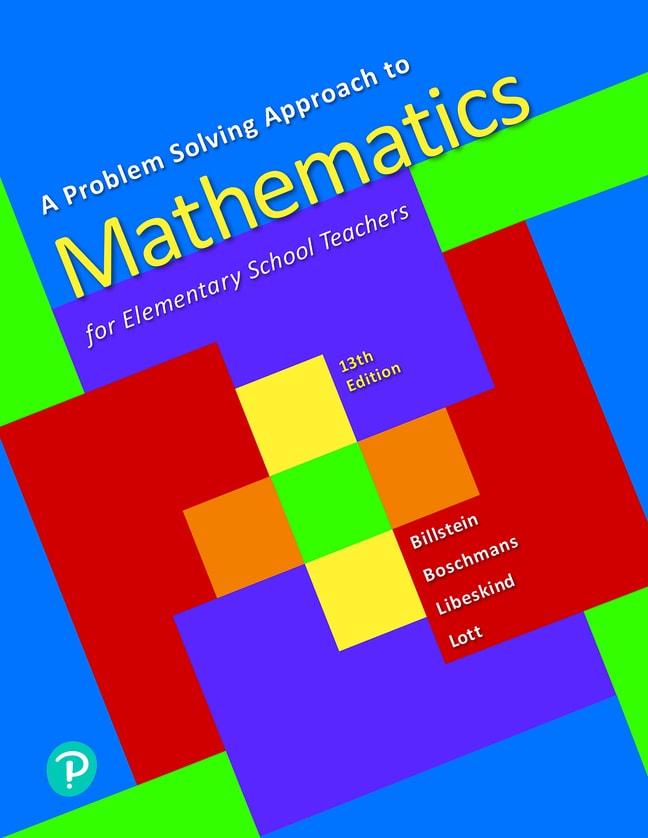
Problem Solving Approach to Mathematics for Elementary School Teachers, A, 13th edition
- Rick Billstein
- , Barbara Boschmans
- , Shlomo Libeskind
- , Johnny Lott

- Watch and learn
Videos & animations bring concepts to life
- Listen on the go
Learn how you like with full eTextbook audio
- Find it fast
Quickly navigate your eTextbook with search
- Stay organized
Access all your eTextbooks in one place
- Easily continue access
Keep learning with auto-renew
A Problem Solving Approach to Mathematics for Elementary School Teachers offers a concept-rich, skill-based presentation that helps prepare you to become an outstanding elementary math teacher. It not only helps future teachers learn the math, but creates an invaluable reference by including professional development features and discussion of today's standards. Revised throughout to prepare you more effectively for your own classroom, the 13th Edition offers a variety of approaches and encourages discussion and collaboration. The Common Core Standards are used in the text to highlight concepts. The National Council of Teachers of Mathematics (NCTM) publications, “Principles and Standards of School Mathematics” and “Principles to Actions: Ensuring Mathematical Success for All” are reflected throughout.
Published by Pearson (July 15th 2020) - Copyright © 2020
ISBN-13: 9780136880141
Subject: Math for Future Teachers
Category:
- An Introduction to Problem Solving
- 1-1 Mathematics and Problem Solving
- 1-2 Explorations with Patterns
- Chapter 1 Review
- Introduction to Logic and Sets
- 2-1 Reasoning and Logic: An Introduction
- 2-2 Describing Sets
- 2-3 Other Set Operations
- Chapter 2 Review
- Numeration Systems and Whole Number Operations
- 3-1 Numeration Systems
- 3-2 Addition of Whole Numbers
- 3-3 Subtraction of Whole Numbers
- 3-4 Multiplication of Whole Numbers
- 3-5 Division of Whole Numbers
- Chapter 3 Review
- Number Theory
- 4-1 Divisibility
- 4-2 Prime and Composite Numbers
- 4-3 Greatest Common Divisor and Least Common Multiple
- * Module A: Clock and Modular Arithmetic–online
- Chapter 4 Review
- Integers
- 5-1 Addition and Subtraction of Integers
- 5-2 Multiplication and Division of Integers
- Chapter 5 Review
- Rational Numbers and Proportional Reasoning
- 6-1 The Set of Rational Numbers
- 6-2 Addition, Subtraction, and Estimation with Rational Numbers
- 6-3 Multiplication, Division, and Estimation with Rational Numbers
- 6-4 Proportional Reasoning
- Chapter 6 Review
- Decimals, Percents, and Real Numbers
- 7-1 Terminating Decimals
- 7-2 Operations on Decimals
- 7-3 Repeating Decimals
- 7-4 Percents
- 7-5 Real Numbers
- Chapter 7 Review
- Algebraic Thinking
- 8-1 Variables
- 8-2 Equals Relation and Equations
- 8-3 Functions
- 8-4 Equations in a Cartesian Coordinate System
- * Module B: Using Real Numbers in Equations–online
- Chapter 8 Review
- Probability
- 9-1 Determining Probabilities
- 9-2 Multistage Experiments and Modeling Games
- 9-3 Simulations and Applications in Probability
- 9-4 Permutations and Combinations in Probability
- Chapter 9 Review
- Data Analysis/Statistics: An Introduction
- 10-1 Designing Experiments/Collecting Data
- 10-2 Displaying Data: Part I
- 10-3 Displaying Data: Part II
- 10-4 Measures of Central Tendency and Variation
- Chapter 10 Review
- Introductory Geometry
- 11-1 Basic Notions
- 11-2 Curves, Polygons, and Symmetry
- 11-3 More About Angles
- 11-4 Geometry in Three Dimensions
- * Module C: Networks–online
- Chapter 11 Review
- Congruence and Similarity with Constructions
- 12-1 Congruence Through Constructions
- 12-2 Additional Congruence Theorems
- 12-3 Additional Constructions
- 12-4 Similar Triangles and Other Similar Figures
- * Module D: Trigonometry Ratios via Similarity–online
- Chapter 12 Review
- Area, Pythagorean Theorem, and Volume
- 13-1 Linear Measure
- 13-2 Areas of Polygons and Circles
- 13-3 The Pythagorean Theorem, Distance Formula, and Equation of a Circle
- 13-4 Surface Areas
- 13-5 Volume, Mass, and Temperature
- Chapter 13 Review 890
- Technology Modules
- * Module E: Spreadsheets–online
- * Module F: Graphing Calculators–online
- * Module H: GeoGebra–online
- Transformations
- 14-1 Translations, Rotations, and Tessellations
- 14-2 Reflections and Glide Reflections
- 14-3 Dilations 935
- Chapter 14 Review